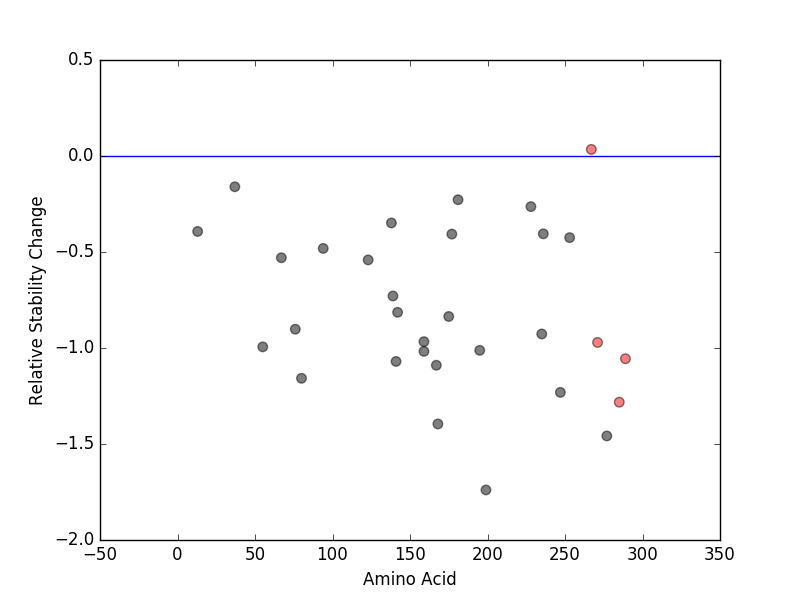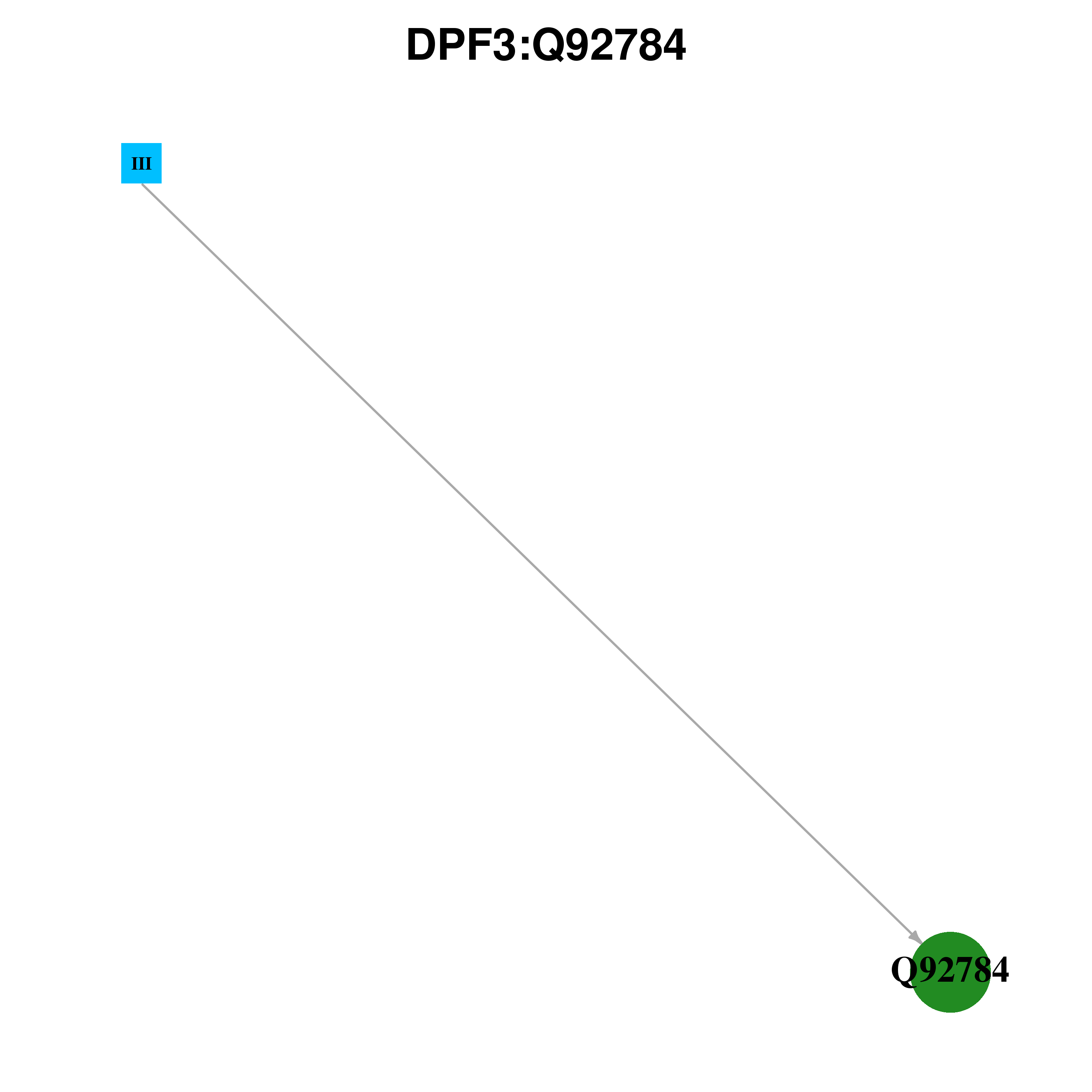| Ligand ID | Ligand short name | Ligand long name | PDB ID | PDB name | mutLBS |
ZN | | ZINC(2+) | 2kwj | A | C284 | ZN | | ZINC(2+) | 2kwk | A | C284 | ZN | | ZINC(2+) | 2kwn | A | C284 | ZN | | ZINC(2+) | 2kwo | A | C284 | III | | Peptide ligand (ALA,ARG,THR,LYS,GLN,THR,ALA,ARG,LYS,SER,THR,GLY,GLY,LYS,ALA,PRO,ARG,LYS,GLN,LEU) | 2kwj | A | L266 R289 | ZN | | ZINC(2+) | 2kwk | A | N272 | ZN | | ZINC(2+) | 2kwo | A | N272 | III | | Peptide ligand (GLY,LEU,GLY,LYS,GLY,GLY,ALA,LYS,ARG,HIS,ARG,LYS,VAL,LEU,ARG) | 2kwn | A | R289 | III | | Peptide ligand (SER,GLY,ARG,GLY,LYS,GLY,GLY,LYS,GLY,LEU,GLY,LYS,GLY,GLY,ALA,LYS,ARG,HIS,ARG,LYS) | 2kwo | A | R289 |
| LBS | AA sequence | # species | Species |
C262 | IPNNYCDFCLG | 3 | Homo sapiens, Mus musculus, Gallus gallus | C262 | EISTSCDFCSG | 1 | Caenorhabditis elegans | C262 | IPNDYCDFCLG | 1 | Danio rerio | C265 | NYCDFCLGGSN | 3 | Homo sapiens, Mus musculus, Gallus gallus | C265 | TSCDFCSGTAF | 1 | Caenorhabditis elegans | C265 | DYCDFCLGDSG | 1 | Danio rerio | C284 | EELVSCADCGR | 2 | Homo sapiens, Mus musculus | C284 | EELVSCSDCGR | 2 | Danio rerio, Gallus gallus | C284 | EDLVSCHDCGR | 1 | Caenorhabditis elegans | C287 | VSCADCGRSGH | 2 | Homo sapiens, Mus musculus | C287 | VSCSDCGRSGH | 2 | Danio rerio, Gallus gallus | C287 | VSCHDCGRSGH | 1 | Caenorhabditis elegans | C295 | SGHPTCLQFTL | 2 | Homo sapiens, Mus musculus | C295 | SGHPSCLNFNQ | 1 | Caenorhabditis elegans | C295 | SGHPSCLQFTD | 1 | Danio rerio | C295 | SGHPTCLQFTT | 1 | Gallus gallus | C313 | TYKWQCIECKS | 2 | Homo sapiens, Mus musculus | C313 | TYQWQCIECKS | 2 | Danio rerio, Gallus gallus | C313 | RSGWQCLECKS | 1 | Caenorhabditis elegans | C316 | WQCIECKSCIL | 2 | Homo sapiens, Mus musculus | C316 | WQCIECKSCSL | 2 | Danio rerio, Gallus gallus | C316 | WQCLECKSCTI | 1 | Caenorhabditis elegans | C334 | DQLLFCDDCDR | 4 | Homo sapiens, Danio rerio, Mus musculus, Gallus gallus | C334 | DKLLFCDDCDR | 1 | Caenorhabditis elegans | C337 | LFCDDCDRGYH | 5 | Homo sapiens, Caenorhabditis elegans, Danio rerio, Mus musculus, Gallus gallus | C360 | EGSWSCHLCWE | 2 | Homo sapiens, Mus musculus | C360 | DDEYSCRLCQV | 1 | Caenorhabditis elegans | C360 | EGSWSCHLCQN | 1 | Danio rerio | C360 | EGSWSCHLCRE | 1 | Gallus gallus | C363 | WSCHLCWELLK | 2 | Homo sapiens, Mus musculus | C363 | YSCRLCQVEFG | 1 | Caenorhabditis elegans | C363 | WSCHLCQNLLK | 1 | Danio rerio | C363 | WSCHLCRELLR | 1 | Gallus gallus | D263 | PNNYCDFCLGG | 3 | Homo sapiens, Mus musculus, Gallus gallus | D263 | ISTSCDFCSGT | 1 | Caenorhabditis elegans | D263 | PNDYCDFCLGD | 1 | Danio rerio | D328 | GTSENDDQLLF | 4 | Homo sapiens, Danio rerio, Mus musculus, Gallus gallus | D328 | GTSENDDKLLF | 1 | Caenorhabditis elegans | D329 | TSENDDQLLFC | 4 | Homo sapiens, Danio rerio, Mus musculus, Gallus gallus | D329 | TSENDDKLLFC | 1 | Caenorhabditis elegans | D335 | QLLFCDDCDRG | 4 | Homo sapiens, Danio rerio, Mus musculus, Gallus gallus | D335 | KLLFCDDCDRG | 1 | Caenorhabditis elegans | D338 | FCDDCDRGYHM | 4 | Homo sapiens, Danio rerio, Mus musculus, Gallus gallus | D338 | FCDDCDRGYHL | 1 | Caenorhabditis elegans | E315 | KWQCIECKSCI | 2 | Homo sapiens, Mus musculus | E315 | QWQCIECKSCS | 2 | Danio rerio, Gallus gallus | E315 | GWQCLECKSCT | 1 | Caenorhabditis elegans | E355 | VAEPPEGSWSC | 2 | Homo sapiens, Mus musculus | E355 | LEKAPDDEYSC | 1 | Caenorhabditis elegans | E355 | MTQPPEGSWSC | 1 | Danio rerio | E355 | VFEPPEGSWSC | 1 | Gallus gallus | F264 | NNYCDFCLGGS | 3 | Homo sapiens, Mus musculus, Gallus gallus | F264 | STSCDFCSGTA | 1 | Caenorhabditis elegans | F264 | NDYCDFCLGDS | 1 | Danio rerio | F298 | PTCLQFTLNMT | 2 | Homo sapiens, Mus musculus | F298 | PSCLNFNQNVT | 1 | Caenorhabditis elegans | F298 | PSCLQFTDNMM | 1 | Danio rerio | F298 | PTCLQFTTNMT | 1 | Gallus gallus | F333 | DDQLLFCDDCD | 4 | Homo sapiens, Danio rerio, Mus musculus, Gallus gallus | F333 | DDKLLFCDDCD | 1 | Caenorhabditis elegans | G291 | DCGRSGHPTCL | 3 | Homo sapiens, Mus musculus, Gallus gallus | G291 | DCGRSGHPSCL | 2 | Caenorhabditis elegans, Danio rerio | G356 | AEPPEGSWSCH | 2 | Homo sapiens, Mus musculus | G356 | EKAPDDEYSCR | 1 | Caenorhabditis elegans | G356 | TQPPEGSWSCH | 1 | Danio rerio | G356 | FEPPEGSWSCH | 1 | Gallus gallus | H292 | CGRSGHPTCLQ | 3 | Homo sapiens, Mus musculus, Gallus gallus | H292 | CGRSGHPSCLN | 1 | Caenorhabditis elegans | H292 | CGRSGHPSCLQ | 1 | Danio rerio | I314 | YKWQCIECKSC | 2 | Homo sapiens, Mus musculus | I314 | YQWQCIECKSC | 2 | Danio rerio, Gallus gallus | I314 | SGWQCLECKSC | 1 | Caenorhabditis elegans | K317 | QCIECKSCILC | 2 | Homo sapiens, Mus musculus | K317 | QCIECKSCSLC | 2 | Danio rerio, Gallus gallus | K317 | QCLECKSCTIC | 1 | Caenorhabditis elegans | L266 | YCDFCLGGSNM | 3 | Homo sapiens, Mus musculus, Gallus gallus | L266 | SCDFCSGTAFM | 1 | Caenorhabditis elegans | L266 | YCDFCLGDSGS | 1 | Danio rerio | L296 | GHPTCLQFTLN | 2 | Homo sapiens, Mus musculus | L296 | GHPSCLNFNQN | 1 | Caenorhabditis elegans | L296 | GHPSCLQFTDN | 1 | Danio rerio | L296 | GHPTCLQFTTN | 1 | Gallus gallus | L331 | ENDDQLLFCDD | 4 | Homo sapiens, Danio rerio, Mus musculus, Gallus gallus | L331 | ENDDKLLFCDD | 1 | Caenorhabditis elegans | L332 | NDDQLLFCDDC | 4 | Homo sapiens, Danio rerio, Mus musculus, Gallus gallus | L332 | NDDKLLFCDDC | 1 | Caenorhabditis elegans | M302 | QFTLNMTEAVK | 2 | Homo sapiens, Mus musculus | M302 | NFNQNVTKIIK | 1 | Caenorhabditis elegans | M302 | QFTDNMMQAVR | 1 | Danio rerio | M302 | QFTTNMTEAVK | 1 | Gallus gallus | M343 | DRGYHMYCLNP | 3 | Homo sapiens, Mus musculus, Gallus gallus | M343 | DRGYHLYCLTP | 1 | Caenorhabditis elegans | M343 | DRGYHMYCLKP | 1 | Danio rerio | N272 | GGSNMNKKSGR | 3 | Homo sapiens, Mus musculus, Gallus gallus | N272 | GTAFMNKNTKL | 1 | Caenorhabditis elegans | N272 | GDSGSNRKTGQ | 1 | Danio rerio | P353 | PPVAEPPEGSW | 2 | Homo sapiens, Mus musculus | P353 | PALEKAPDDEY | 1 | Caenorhabditis elegans | P353 | PPMTQPPEGSW | 1 | Danio rerio | P353 | PPVFEPPEGSW | 1 | Gallus gallus | P354 | PVAEPPEGSWS | 2 | Homo sapiens, Mus musculus | P354 | ALEKAPDDEYS | 1 | Caenorhabditis elegans | P354 | PMTQPPEGSWS | 1 | Danio rerio | P354 | PVFEPPEGSWS | 1 | Gallus gallus | Q297 | HPTCLQFTLNM | 2 | Homo sapiens, Mus musculus | Q297 | HPSCLNFNQNV | 1 | Caenorhabditis elegans | Q297 | HPSCLQFTDNM | 1 | Danio rerio | Q297 | HPTCLQFTTNM | 1 | Gallus gallus | Q330 | SENDDQLLFCD | 4 | Homo sapiens, Danio rerio, Mus musculus, Gallus gallus | Q330 | SENDDKLLFCD | 1 | Caenorhabditis elegans | R289 | CADCGRSGHPT | 2 | Homo sapiens, Mus musculus | R289 | CHDCGRSGHPS | 1 | Caenorhabditis elegans | R289 | CSDCGRSGHPS | 1 | Danio rerio | R289 | CSDCGRSGHPT | 1 | Gallus gallus | R339 | CDDCDRGYHMY | 4 | Homo sapiens, Danio rerio, Mus musculus, Gallus gallus | R339 | CDDCDRGYHLY | 1 | Caenorhabditis elegans | S290 | ADCGRSGHPTC | 2 | Homo sapiens, Mus musculus | S290 | HDCGRSGHPSC | 1 | Caenorhabditis elegans | S290 | SDCGRSGHPSC | 1 | Danio rerio | S290 | SDCGRSGHPTC | 1 | Gallus gallus | S318 | CIECKSCILCG | 2 | Homo sapiens, Mus musculus | S318 | CIECKSCSLCG | 2 | Danio rerio, Gallus gallus | S318 | CLECKSCTICG | 1 | Caenorhabditis elegans | S325 | ILCGTSENDDQ | 2 | Homo sapiens, Mus musculus | S325 | SLCGTSENDDQ | 2 | Danio rerio, Gallus gallus | S325 | TICGTSENDDK | 1 | Caenorhabditis elegans | S357 | EPPEGSWSCHL | 3 | Homo sapiens, Mus musculus, Gallus gallus | S357 | KAPDDEYSCRL | 1 | Caenorhabditis elegans | S357 | QPPEGSWSCHL | 1 | Danio rerio | S359 | PEGSWSCHLCW | 2 | Homo sapiens, Mus musculus | S359 | PDDEYSCRLCQ | 1 | Caenorhabditis elegans | S359 | PEGSWSCHLCQ | 1 | Danio rerio | S359 | PEGSWSCHLCR | 1 | Gallus gallus | W311 | VKTYKWQCIEC | 2 | Homo sapiens, Mus musculus | W311 | IKRSGWQCLEC | 1 | Caenorhabditis elegans | W311 | VRTYQWQCIEC | 1 | Danio rerio | W311 | VKTYQWQCIEC | 1 | Gallus gallus | W358 | PPEGSWSCHLC | 4 | Homo sapiens, Danio rerio, Mus musculus, Gallus gallus | W358 | APDDEYSCRLC | 1 | Caenorhabditis elegans | Y261 | VIPNNYCDFCL | 2 | Homo sapiens, Mus musculus | Y261 | IEISTSCDFCS | 1 | Caenorhabditis elegans | Y261 | IIPNDYCDFCL | 1 | Danio rerio | Y261 | IIPNNYCDFCL | 1 | Gallus gallus |
 Gene summary
Gene summary  Gene ontology having evidence of Inferred from Direct Assay (IDA) from Entrez
Gene ontology having evidence of Inferred from Direct Assay (IDA) from Entrez  Lollipop-style diagram of mutations at LBS in amino-acid sequence.
Lollipop-style diagram of mutations at LBS in amino-acid sequence. 
 Cancer type specific mutLBS sorted by frequency
Cancer type specific mutLBS sorted by frequency Relative protein structure stability change (ΔΔE) using Mupro 1.1
Relative protein structure stability change (ΔΔE) using Mupro 1.1  : nsSNV at non-LBS
: nsSNV at non-LBS : nsSNV at LBS
: nsSNV at LBS
 nsSNVs sorted by the relative stability change of protein structure by each mutation
nsSNVs sorted by the relative stability change of protein structure by each mutation  Structure image for DPF3 from PDB
Structure image for DPF3 from PDB Differential gene expression between mutated and non-mutated LBS samples in all 16 major cancer types
Differential gene expression between mutated and non-mutated LBS samples in all 16 major cancer types Differential co-expressed gene network based on protein-protein interaction data (CePIN)
Differential co-expressed gene network based on protein-protein interaction data (CePIN) Gene level disease information (DisGeNet)
Gene level disease information (DisGeNet)  Mutation level pathogenic information (ClinVar annotation)
Mutation level pathogenic information (ClinVar annotation)  Gene expression profile of anticancer drug treated cell-lines (CCLE)
Gene expression profile of anticancer drug treated cell-lines (CCLE)
 Drug information targeting mutLBSgene (Approved drugs only)
Drug information targeting mutLBSgene (Approved drugs only) Gene-centered ligand-gene interaction network
Gene-centered ligand-gene interaction network 
 Ligands binding to mutated ligand binding site of DPF3 go to BioLip
Ligands binding to mutated ligand binding site of DPF3 go to BioLip Multiple alignments for Q92784 in multiple species
Multiple alignments for Q92784 in multiple species 
